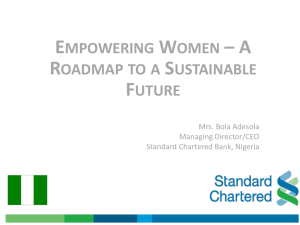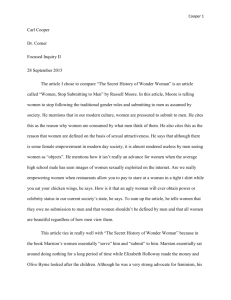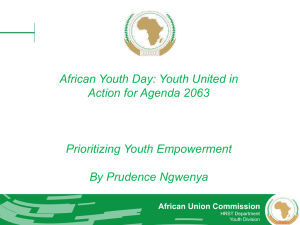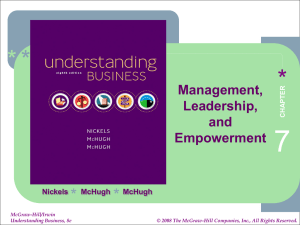female workers in post disaster reco female workers in post disaster
advertisement
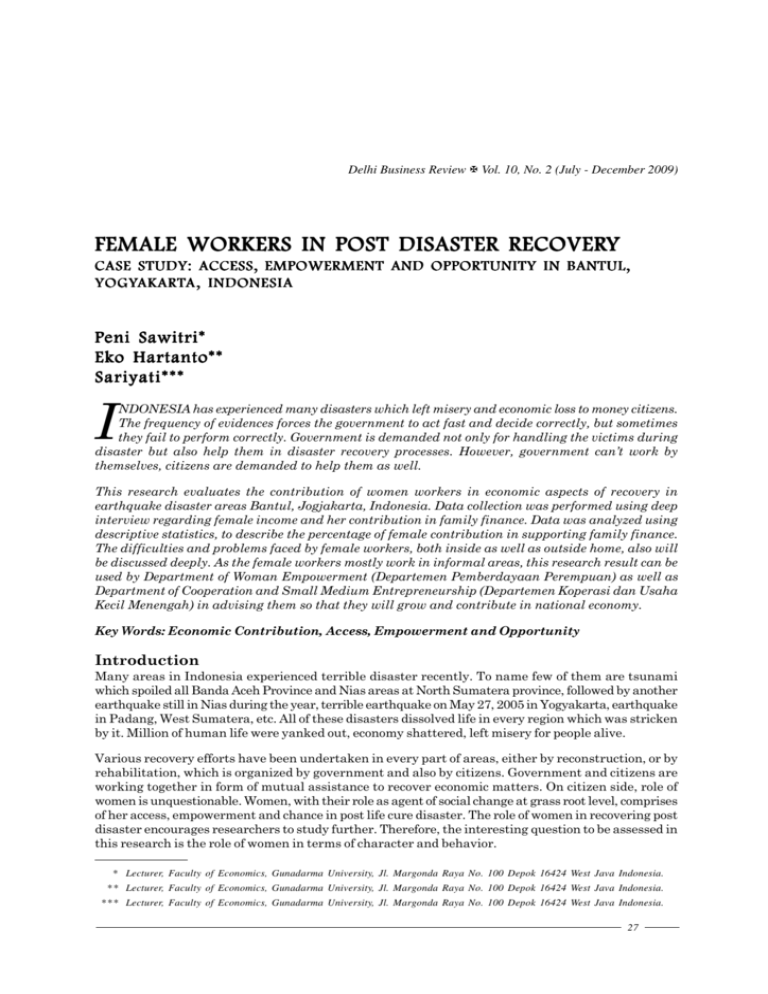
Delhi Business Review X Vol. 10, No. 2 (July - December 2009) FEMALE WORKERS IN POST DISASTER RECO VER Y RECOVER VERY CASE STUDY: ACCESS, EMPOWERMENT AND OPPORTUNITY IN BANTUL, NESIA TA, INDO AKAR YOGY INDONESIA AKART YOGYAKAR Peni Sawitri* Eko Hartanto** Sariyati*** I NDONESIA has experienced many disasters which left misery and economic loss to money citizens. The frequency of evidences forces the government to act fast and decide correctly, but sometimes they fail to perform correctly. Government is demanded not only for handling the victims during disaster but also help them in disaster recovery processes. However, government can’t work by themselves, citizens are demanded to help them as well. This research evaluates the contribution of women workers in economic aspects of recovery in earthquake disaster areas Bantul, Jogjakarta, Indonesia. Data collection was performed using deep interview regarding female income and her contribution in family finance. Data was analyzed using descriptive statistics, to describe the percentage of female contribution in supporting family finance. The difficulties and problems faced by female workers, both inside as well as outside home, also will be discussed deeply. As the female workers mostly work in informal areas, this research result can be used by Department of Woman Empowerment (Departemen Pemberdayaan Perempuan) as well as Department of Cooperation and Small Medium Entrepreneurship (Departemen Koperasi dan Usaha Kecil Menengah) in advising them so that they will grow and contribute in national economy. Key Words: Economic Contribution, Access, Empowerment and Opportunity Introduction Many areas in Indonesia experienced terrible disaster recently. To name few of them are tsunami which spoiled all Banda Aceh Province and Nias areas at North Sumatera province, followed by another earthquake still in Nias during the year, terrible earthquake on May 27, 2005 in Yogyakarta, earthquake in Padang, West Sumatera, etc. All of these disasters dissolved life in every region which was stricken by it. Million of human life were yanked out, economy shattered, left misery for people alive. Various recovery efforts have been undertaken in every part of areas, either by reconstruction, or by rehabilitation, which is organized by government and also by citizens. Government and citizens are working together in form of mutual assistance to recover economic matters. On citizen side, role of women is unquestionable. Women, with their role as agent of social change at grass root level, comprises of her access, empowerment and chance in post life cure disaster. The role of women in recovering post disaster encourages researchers to study further. Therefore, the interesting question to be assessed in this research is the role of women in terms of character and behavior. * Lecturer, Faculty of Economics, Gunadarma University, Jl. Margonda Raya No. 100 Depok 16424 West Java Indonesia. * * Lecturer, Faculty of Economics, Gunadarma University, Jl. Margonda Raya No. 100 Depok 16424 West Java Indonesia. *** Lecturer, Faculty of Economics, Gunadarma University, Jl. Margonda Raya No. 100 Depok 16424 West Java Indonesia. 27 Peni Sawitri, Eko Hartanto and Sariyati Various researches regarding female role on economic development have been done, for instances Simanjuntak (2001), Sajogyo, et al. (1980). According to Simanajuntak (2001), women have given big contribution to family welfare, notably economic criteria. As well as Sajogyo et al. (1980) analyzing female laboring participation at Javanese rural West, concluded that there exists distinctive role (differentiation) between male and female family members. Mostly, female at rural area contributes earning to support if not as the main income for family expenditures. Women not only perform everyday housework but also put their energy at production area or any other earning work. Literature Review Learning about women worker or career women has become an interesting topic these days. Let us see the meaning of career itself. Career can be defined as (1) developing and progressing in life, work, responsible position, and (2) work that give expectation for forward. Women who pursue on career, become woman who has work to develop her career also called as “career women,” but this research is tending more as women worker. Research of Sajida and Alvi (2002) on Indonesian women career development, shows that women already experienced fruitfulness in her career. The result says successful career women set high goals for themselves and displayed a strong commitment to achieve them. In taking on multiple life roles, they obviously reflected the effects of traditional gender socialization, but increasingly tampered by a desire to forge a new identity, one which must include a challenging and fulfilling career. They found creative ways of balancing their multiple roles, often with the support of husband and other members of their family. Their commitment to the family was immense, reflecting the cherished family values of Indonesian society. Munandar (2001) pointed out that women face more of career obstacle than man. Similar observation also made by Karjadi (1996). He focused on identifying factors that influence women career. A case study at Surabaya’s municipality, with sample of 100 women who work at institution or firm, minimum graduated from secondary school and getting married was done. Generally, he concludes that four variables, such as education, experience, enthusiasm and acclamatization influence career women work performance. Work performance of career women can be explained by those 4 factors as much as 78.83%. Among variables, acclamatization has the strongest influence (internal factor). The development of career for woman has also become interesting research topic. Nurhaeni (1997) found that there exists conflict in development of women potency in her career. A case study of women public servant shows that they perceive the structurally responsible position for them is marriage and to have kid. Result of research indicates that women worker have positive self-concept. It removes progressively steady if her husband and children are supportive. The problem emerges when husband does not support and kids still need nursing. Conflict arises in time management, since the women has to do housework, playing as wife who shall serve her husband, as mother who shall serve her kids, as well to allocate her time to office works. As well, Sadli (2001) found that woman self esteem development is a positive identity development, and constitutes feminism that is not especially complementary to masculinity. Sadli also offers one of eligible model that can be chosen to develop positive identity is androgyny model. Using androgyny model, worker choose women positive aspects from feminism and masculinity in developing her identity. As we know all, characteristic is not emotional but affection ability, adequate captains and get empathy, rational at a swoop apprehensive, assertive and sensitive in subjective interpersonal, depends to the situation that corresponds to various behavior. Research about working opportunity for women has also become main interest of many researchers, such as Sulaiman (1985). They found that there are many opportunities for women to work at rural, especially at handicraft industrial sector, such as batik, whiz, crochet, crockery, weave, jumputan, 28 Delhi Business Review X Vol. 10, No. 2 (July - December 2009) leather product, cigarette, garment, rigging, etc. Rural female really constitutes worker in crafting/ diligence art, evident with diligence art observation that miscellaneous, in role that directly and indirect, role prescriptive or even just role helper. According to Sulaiman (1985) opportunity tries at momentous diligence area to be entered female. In is in fact, valley girl that tries at diligence area always consisting of soiled owner female, pamong’s wife female or more other profession outdoor cogent agricultural and female businessman diligence. From various studies which have been stated above, we can conclude that woman workers empowerment will give significant role on household economy recovery as well as national economy. Research Questions This research is done especially for studying how Bantul’s women society workers have access, empowerment and opportunity in rebuilding their economic vocation through handicraft industry. Handicraft industry at Bantul has reached the time to become excellent regional economic backbone. So the proposed research questions are as follows: 1. How do the accesses or position of Bantul’s female workers help in economic recovery post disaster? 2. How do the patterns of Bantul’s women empowerment help in developing themselves potency as worker partaking share in economic recovery post disaster? 3. How Bantul’s women utilize opportunity that is proprietary in participating in post economic disaster cure? Research Method Variables Measurement Concepts in this research describe all women career development potency in their work, such as access, empowerment and chance/opportunity concepts. Let’s define first women worker concept in this research, i.e. women who works on handy craft industry. Variables which are used in this research are categorized as abstract variables. Access is defined as woman position on work, and measured using nominal scale. In measuring access, we adopted Sulaiman’s categories (1985) which is: l Paid worker, produce handicraft and get paid for that. l Worker and owner, produce handicraft by herself and own the business, she is an entrepreneur. Empowerment was measured using five-item scale that adopts female spirit development measurement which is known as androgyny model by Sadli (2001). Question was developed to explore women perception about their ability in development of self empowerment. Androgyny model is differentiated into feminism and masculinity dimensions. Both dimensions measured by 5 questions on first order, which tend to masculinity, i.e. emotional, critical, decision making, leadership and independency abilities. The next 5 questions are intended to point out feminists’ trends. The dimensions of feminism are empathy, sincerity and hardiness, lovable, tender, warm, careful, and dress suitably. Opportunity variable was measured using ordinal measurement scale. Opportunity in this case is chance to get job or create own business having developed her ability by attending training program or participate in an exhibition which is organized by government or private organizer. Opportunity measurement was done by adopting measurement which was developed by Sulaiman’s (1985). Rule which is used to quantify dimension of opportunity variable is: l Score 1 is assigned for voluntary female workers in their family business. 29 Peni Sawitri, Eko Hartanto and Sariyati l Score 2 is assigned for female workers paid with minimum payment and never been yet trained formally. l Score 3 if female workers paid normally as other workers get, and also have attended training formally. l Score 4 for female entrepreneurs but never yet trained formally. l Score 5 for female entrepreneurs who have got opportunity in participating in an exhibition and/or got aid from government or private organizers. Sample and Data Collection Research population is all women workers at various handicraft centre at Bantul regency, Yogyakarta, Indonesia. As the number of women workers is too many to be included in this research, a sample was chosen from the population. Sampling technique deployed is purposive sampling. The criteria which was used to choose the sample was working at handicraft business and have worked at least 1 year. As the data explores from respondents, who are women workers, questionnaire was deployed as research instrument. Interview method was preferred instead of self-administered questionnaire, to overcome the possibility of unwillingness to fill the questionnaire by themselves. Data collected further was analyzed using statistical techniques. Results and Analysis Access of Female Workers As shown in Table 1, only 32 respondents were successfully interviewed. Based on Larasati categories, respondents were divided into worker labors and entrepreneurs. Worker labors consist of 15 respondents (equal to 46.875%), whereas entrepreneurs consist of 17 (53.25%) respondents. Women entrepreneurs mostly start as paid worker and as time goes, they become capable to create their own business. Table 1: Respondents based on Employment Categorization Employment Category Total Percentage Worker Labors 15 46.875% Entrepreneurs 17 53.125% Total 32 100% Source: Primary Data As an example, Yusna, owner of Venda Souvenir, started her business by deploying her vacant time. In the meantime, she also joined training in small and medium entrepreneurs development that were organized by private organizers, her business got settled and made big profits. She can gain on the average of 10 million until 15 million Indonesian Rupiah (IDR) daily and penetrated a variety of market regions in Indonesia, such as Jakarta, Semarang, Surabaya, Bandung, Kalimantan and Jambi. Same phenomena was shown by Sulastri, who owned traditional garment business known as batik to Indonesian people. She began her business as a hobby. From hobby became main business as she continually improved her ability in batik art by joining batik training every time a chance exists. Her hobby in batik art now become home industry business which produce 1000 pieces printed 30 Delhi Business Review X Vol. 10, No. 2 (July - December 2009) batik and 20 pieces batik tulis (hand made) monthly. Talking about salary, female workers salaries range from 150,000,- 550,000,- IDR monthly as can be seen in Table 2. About 40% of respondents earn salary from 350,001,- 450,000,- IDR. Only 6.67% of respondents earn salary ranging from 450,001,- 550,000,- IDR. With this income, even though it’s very small (rupiah exchange rate into US dollar at that time is about 11,500 IDR for every one dollar), woman workers capable to assist their husbands. Business areas which women workers involve mostly are in various small enterprises such as traditional batik, batik handicraft, dried flowers, eggshells ceramic handicraft, and other souvenirs. Table 2: Women Workers Salary Salary (IDR) Total Percentage 150,000 – 250,000 5 33.3% 250,001 – 350,000 3 20% 350,001 – 450,000 6 40% 450,001 – 550,000 1 6.67% Source: Primary Data Table 3 shows monthly revenue of SME which is managed and run by women. Most of them, more than 76% of respondents, have revenue ranging from 1,000,000 - 15,000,000,- IDR monthly. Spectacularly, more than 17% of respondents gain from 30,000,001- 45,000,000,- IDR monthly. But still the women entrepreneurs complaining low revenue resulted because they weren’t assisted to develop their capability in running business nor in production by participating in training or exhibition. Table 3: Monthly Revenue SME which is Run by Womenn Revenue/Month (in IDR) Total Percentage 1,000,000 – 15,000,000 13 76. 47% 15,000,001 – 30,000,000 1 5.88% 30,000,001 – 45,000,000 3 17.65% Source: Primary Data Another example, a home industry which produces handicraft, i.e., dry flower from by product of corn, from the beginning the owner never got support, neither capital support, management training, nor exhibition information. As concluded from the interview, the owner really needs support from government. Not to forget a small business, which is run by You Menik. This business produces garment which is known as ‘batik.” She can earn 15 million IDR monthly with 6 workers, but she still expects support from government, especially in marketing. She experienced that her product is bought by retailers with low price and then sold using different brand with higher price. Actually she doesn’t want her product use different brand on retailer level, but unfortunately she lacks marketing knowledge and experience. Therefore, if women entrepreneurs are continually trained and asked to participate in exhibition, this figure is expected to rise. To be true, there are various programs which are offered either by government or private 31 Peni Sawitri, Eko Hartanto and Sariyati organizations to support home and small industries, especially at ex disaster areas. At Bantul particularly, the programs were conducted by government, private organizations either nationally or internationally, and also organized by Bantul citizen. Unfortunately, as concluded from the interview, almost all programs were known only to few women entrepreneurs, such as Titik, the owner of ceramics handicraft, and also Yu Legi, who own crockery handicraft. Before disaster which ruined Jogja economically as well as socially, Titik could earn 5 millions IDR monthly. She was able to earn 2 millions IDR monthly after the disaster. She admitted, since the receiving of capital support, her business started to grow. She got capital injection without interest and guarantee. Same thing happened with business run by Yu Legi. Since the receiving of capital injection, the business started to produce and grow constantly. Empowerment As mentioned before, women empowerment was measured using five-point scale, which capture women perception about their ability in development of self empowerment. The masculinity dimensions are emotional, critical, decision making, leadership, and independency abilities. The feminism dimensions are empathy, sincerity and hardiness, lovable, tender, warm, careful, and dress suitably. The score of 32 women workers is shown in Table 4. Respondents answers to emotional and decision making abilities dimensions range from 2 to 5. On the other hand, critical, leadership, and independency abilities range from 3 to 5. Even though 2 dimensions, i.e. emotional and decision making abilities have same range, the average is different. The average of emotional ability is 4.125, less than the average of decision making ability, i.e., 4.5. The average of critical ability is 3.75, which is the lowest average among masculinity dimensions. The score shows that Bantul women workers still behave as Javanese women, accepting everything without arguing. The average of leadership and independency abilities respectively are 4.156 and 4.03. The average of all masculinity dimensions are above median value. From feminism side, abilities to get empathy, and sincerity and hardiness have same range, i.e. 35. Abilities to love and carefulness have same range, from 4 to 5. Dressing ability has the widest range, i.e., from 2 to 5. All feminism dimensions have average value more than median value, i.e. Table 4: Score of Woman Workers Empowerment Dimensions Theoretical Range Respondent Range Average Median Emotional ability 1-5 2-5 4.125 3 Critical ability 1-5 3-5 3.75 3 Decision making ability 1-5 2-5 4.5 3 Leadership ability 1-5 3-5 4.156 3 Independence ability 1-5 3-5 4.03 3 Masculinities 5 - 25 14 - 25 20. 5625 15 Empathy 1-5 3-5 4.125 3 Sincerity and hardiness ability 1-5 3-5 4.125 3 Lovability and tenderly abilities 1-5 4-5 4.1875 3 Warmness and carefulness ability 1-5 4-5 4.28 3 Dressing ability 1-5 2-5 3.625 3 Feminists 5 - 25 17 - 24 20. 3438 15 Source: Primary Data 32 Delhi Business Review X Vol. 10, No. 2 (July - December 2009) 4.125, 4.125, 4.1875, 4.28, and 3.625 respectively for ability to have empathy towards others, sincere and hardiness, lovable, tender, warm, careful, and dress suitably. The sum of masculinity dimensions is 20.5625, which is more than the sum of feminism (20.3438). This score show that Bantul women workers seem characterized by masculinity more than feminism, even we can still see that women workers character is the combination of masculinity and feminism. This is so called androgyny. Bantul women workers are dominant and not emotional, rational but at the same time understanding, assertive and sensitive on interpersonal relationship character. Those characters emerge depending on the situation faced by women workers. Women Workers Opportunity Women workers are categorized into 5 groups, i.e., voluntary work in family business, paid with minimum wages, paid average and have training chance, entrepreneurship without getting any aids, and the last entrepreneurs who get various aids or supports. Table 5 shows the composition of Bantul women workers based on that categorization. The highest percentage is woman entrepreneurs (34.375%) who never got any aids, whether management training, financial or marketing, etc. Following are women workers group with minimum wages and paid average, i.e., 25% respectively. The lowest percentage of women entrepreneurs who got various aids or supports, i.e. 6.25%. Group of women workers who voluntarily work in family business is 9.375%. Table 5: Grouping of Women Workers Opportunity Total Percentage Voluntary at family business 3 9.375% Paid with minimum wages 8 25% Paid averagely and have training chance 8 25% Entrepreneurs who have never joined training 11 34. 375% Entrepreneurs who have been trained and got various aids 2 6.25% Source: Primary Data This statistics shows that women entrepreneurs still need various aids, whether from government or private organizations. Bantul women entrepreneurs start the business without enough business knowledge, not to forget to mention their education level, which is mostly graduated from elementary until high school, training is a must; whether it is management, marketing, financial, or other trainings. Most important also to be considered, delivering the training using non technical or complicated language. Training material should be as simple as possible. Bantul women workers generally do not understand how to recognize changing customer needs. Conclusion The study found that female worker’s access of Bantul in economic recovery post disaster can be figured by their work position at handicraft industrial sector. About 53% of women workers own their business which was started from unusual as a business generally started. Most of them started their business as a hobby or to fill vacant time. But, their business grew unquestionable and became main family business. Earning from the business also supports family expenses. Women workers empowerment at Bantul shows satisfaction. Most of them have high self development characters which is described by the combination of their masculinity and feminist characters. Bantul women workers have characteristics such as unemotional but lovable, have leadership capability, capable to empathize, rational as well as understanding, assertive and sensitive in interpersonal 33 Peni Sawitri, Eko Hartanto and Sariyati relationship. Those characteristics are potential power of women workers to empower themselves better as it is integrated masculine and feminist characters. Bantul women workers contribution for national economic development as well as for family economy is remarkable. Bantul women workers have not figured out deployment chances. About 34.375% of women workers are women entrepreneurs but never yet participated in any training or exhibition, and yet have not got any financial or marketing aids. Implications l Women workers generally can be empowered and economically developed, not only in disaster areas or time, but in other areas also. l Formal education and training are a must for women workers. l Cooperation among ministries of industry, trade, Cooperation and SME, women empowerment, local government, private sectors, and university is needed to help women entrepreneurs to sell their products, manage their business, etc. References Karjadi, Nurtjahja M. (1996), “Factor that Influence Career Woman Work Performance: Case Study at Surabaya’s Municipality” , Universities Observational Institute Airlangga. Munandar, S.C. Utami (2001), “Career Woman: Challenge of and Opportunity”, Passed on by International Women in Seminar Indonesian: Access, Empowerment and Opportunity, Jakarta 14th December 1997, Paper bulk binds books: Woman in Indonesian Society: Access, Empowerment and chance, Sunan Kalijaga Press, Yogyakarta, p.298. Nurhaeni, Ismi Two Astuti (1997), “Conflict Point in Developmental Career Girl Potency: Case Study on Women Civil Public Servant at Surakarta“, Observational Reporting, Surakarta: Study’s Center University Woman Eleven Marches. Sadli, Saparinah (2001), “Supporting Factor and Resistor to Female Spirit Development”, Passed on by International Women in Seminar Indonesian: Access, Empowerment and Opportunity, Jakarta 1 4th December 1997, Paper Bulk Binds Books: Woman in Indonesian Society: Access, Empowerment and Chance, Sunan Kalijaga Press, Yogyakarta, 2001, p.213. Sajida, S. and Alvi, Sabir A. (2002), “Career Development of Women In is Study of Highly Successful Career Women’s Indonesia” Passed on by International Women In’s Seminar Indonesian: Access, Empowerment and Opportunity, Jakarta 1 4th December 1997, Paper Bulk Binds Books: Women in Indonesian Society: Access, Empowerment and Opportunity, Sunan Kalijaga Press, Yogyakarta, p.111. Sajogyo, Pudjiwati, Endang, L. Hastuti, Winati, Wigna and Krisnawati, Suryanata (1980), “The Role of Women in Different Perspective, Rural Dynamics Study”, Agro Economic Survey and Center for Rural Sociological Research, Bogor Agricultural University, Bogor. Simanjuntak, Payaman J. (2001) “Participation and Woman Labor Protection”, Passed on by International Women In’s Seminar Indonesian: Access, Empowerment and Opportunity, Jakarta 14th December 1997, Paper Bulk Binds Books: Woman in Indonesian Society: Access, Empowerment and Chance, Sunan Kalijaga Press, Yogyakarta, 2001, p.187. Sulaiman, Larasati S. (1985), “Diligence, Job and Opportunity Tries to Divide Rural Woman”, Observational Article Bulk Book: Job Opportunity and Tries at Rural, BPFE Yogyakarta, 1985, p.345. 34

